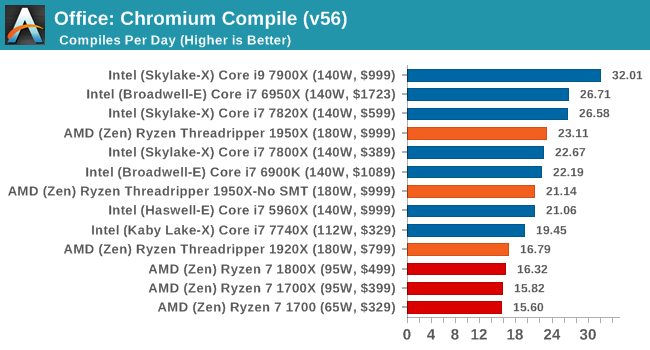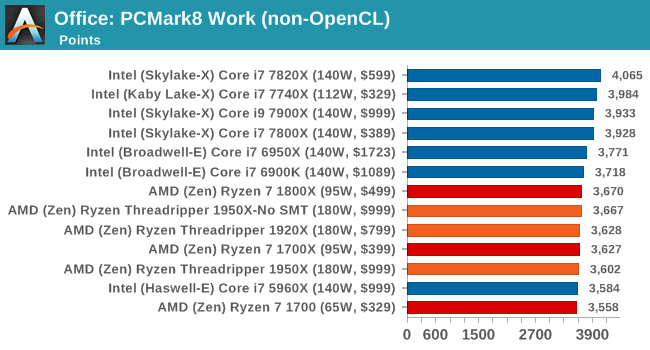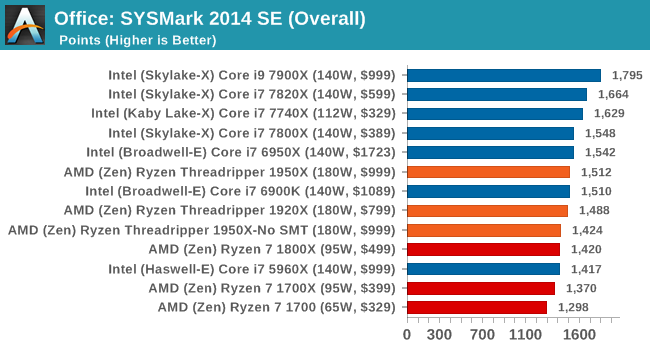The AMD Ryzen Threadripper 1950X and 1920X Review: CPUs on Steroids
by Ian Cutress on August 10, 2017 9:00 AM ESTCPU Office Tests
The office programs we use for benchmarking aren't specific programs per-se, but industry standard tests that hold weight with professionals. The goal of these tests is to use an array of software and techniques that a typical office user might encounter, such as video conferencing, document editing, architectural modeling, and so on and so forth.
All of our benchmark results can also be found in our benchmark engine, Bench.
Chromium Compile (v56)
Our new compilation test uses Windows 10 Pro, VS Community 2015.3 with the Win10 SDK to compile a nightly build of Chromium. We've fixed the test for a build in late March 2017, and we run a fresh full compile in our test. Compilation is the typical example given of a variable threaded workload - some of the compile and linking is linear, whereas other parts are multithreaded.

One of the interesting data points in our test is the Compile, and it is surprising to see the 1920X only just beat the Ryzen 7 chips. Because this test requires a lot of cross-core communication, the fewer cores per CCX there are, the worse the result. This is why the 1950X in SMT-off mode beats the 3 cores-per-CCX 1920X, along with lower latency memory support. We know that this test is not too keen on victim caches either, but it does seem that the 2MB per core ratio does well for the 1950X, and could explain the performance difference moving from 8 to 12 to 16 cores under the Zen microarchitecture.
PCMark8: link
Despite originally coming out in 2008/2009, Futuremark has maintained PCMark8 to remain relevant in 2017. On the scale of complicated tasks, PCMark focuses more on the low-to-mid range of professional workloads, making it a good indicator for what people consider 'office' work. We run the benchmark from the commandline in 'conventional' mode, meaning C++ over OpenCL, to remove the graphics card from the equation and focus purely on the CPU. PCMark8 offers Home, Work and Creative workloads, with some software tests shared and others unique to each benchmark set.


Strangely, PCMark 8's Creative test seems to be failing across the board. We're trying to narrow down the issue.
SYSmark 2014 SE: link
SYSmark is developed by Bapco, a consortium of industry CPU companies. The goal of SYSmark is to take stripped down versions of popular software, such as Photoshop and Onenote, and measure how long it takes to process certain tasks within that software. The end result is a score for each of the three segments (Office, Media, Data) as well as an overall score. Here a reference system (Core i3-6100, 4GB DDR3, 256GB SSD, Integrated HD 530 graphics) is used to provide a baseline score of 1000 in each test.
A note on context for these numbers. AMD left Bapco in the last two years, due to differences of opinion on how the benchmarking suites were chosen and AMD believed the tests are angled towards Intel processors and had optimizations to show bigger differences than what AMD felt was present. The following benchmarks are provided as data, but the conflict of opinion between the two companies on the validity of the benchmark is provided as context for the following numbers.











347 Comments
View All Comments
Vorl - Thursday, August 10, 2017 - link
the answer to both of you is that "this is a High end PC processor, not a workstation CPU, and not a server CPU. That was clearly covered at the start of the article.If you want raw number crunching info, there will be other sites that are going to have those reviews, and really, maybe anandtech will review it in that light since it really is such a powerful CPU in another review for server stuff.
Also, there is a LOT of value in having a standardized set of tests. Even if a few tests here and there are no longer valuable like PDF opening, the same tests being used across the board are important for BENCH. you can't compare products if you aren't using the same tools.
Unfortunately AMD is ahead of the curve currently with massive SMP being given to normal consumers now at a reasonable price. It will take a little time for dev's to catch up and really make use of this amazing CPU.
With the processing power in a CPU like this imagine the game mechanics that can be created and used, For those of us that are more interested in making this a reasonably priced workstation/server build for VMs etc, cool for us, but that isn't where this is being marketed, and it's not really fair to jump all over the reviewer for it.
Zstream - Thursday, August 10, 2017 - link
Utter rubbish. This CPU is designed for a workstation build. Some a product labeled Xeon is a workstation CPU, but this isn't?mapesdhs - Friday, August 11, 2017 - link
Yeah, TR doesn't really look like something that's massively aimed at gamers, it has too many capabilities and features which gamers wouldn't be interested in.pm9819 - Friday, August 18, 2017 - link
AMD themselves call it a consumer cpu. Is Intel paying them as wellLolimaster - Friday, August 11, 2017 - link
It's a HEDT/workstation, a year ago people called Workstation a dual Xeon 8 cores, which a sole 1950X replicates.Intel draws a line not supporting ECC, AMD supports ECC in all their main cpu's server or not all the way back to Athlon 64.
16cores/32threads, ECC, 64 pci-e lanes, upgrade path to 32cores/64threads with zen3. Smells Workstation to me.
Another thing is server cpu's which EPYC is, with features tailored to it, like a massive core count with low clock speeds to maximize efficiency and damn expensive mobos without any gamerish gizmo, just think to put on building without looking at net. TR can do a bit of that too, but optimized to an all around performance and budget friendly.
Ian Cutress - Thursday, August 10, 2017 - link
Dan sums it up. Some of these tests are simply check boxes - is it adequate enough.Some people do say that an automated suite isn't the way to do things: unfortunately without spending over two months designing this script I wouldn't have time for nearly as much data or to test nearly as many CPUs. Automation is a key aspect to testing, and I've spent a good while making sure tests like our Chromium Compile can be process consistent across systems.
There's always scope to add more tests (my scripts are modular now), if they can be repeatable and deterministic, but also easy to understand in how they are set up. Feel free to reach out via email if you have suggestions.
Johan Steyn - Thursday, August 10, 2017 - link
Ian, I understand that you see them as checkboxes, but this is not a normal CPU John doe is going to buy. It has a very specific audience and I feel you are missing that audience badly. I guy that buys this to use for rendering or 3Dstudio Max, is not going to worry about games. Yes, it would be a great bonus to also be OK at it. Other sittes even did tests of running rendering as well as play games at the same time. TR shined like a star against Intel. This is actually something that might happen in real life. A guy could begin a render and then while waiting, decide to play a game.I would not buy TR to open pdf's, would I?
Ian Cutress - Thursday, August 10, 2017 - link
No, but you open things like IDEs and Premiere. A PDF test is a gateway test in that regard with an abnormally large input. When a workstation is not crunching hard, it's being used to navigate through programs with perhaps the web and documents in tow where the UX is going to be indicative of something like PDF opening.Lolimaster - Friday, August 11, 2017 - link
Including useless benchs not only you waste target audience time, you too having to write and upload images from that useless benchs instead of making the article more interesting.How about a "the destroyer for HEDT/Workstion", a typical productivy load + some gaming, out of a sudden people will get TWICE the cpu resources, they can do things they couldn't before on the same machine.
They could get a dual socket mobo with 2x10c Xeons paying the hefty premium with pathetic clock speeds if they wante to game a bit while doing work, TR fixed that, with mass consumer type of gaming performance while reducing the multicore costs by more than half (cores counts + ECC support without paying intel tax).
Lolimaster - Friday, August 11, 2017 - link
And that audience few months ago was limited to do their productivity thing with 6-8 cores or 10 paying the huge intel tax, probably they couldn't game without hurting other things and had a 2 secondary PC for killing time.With TR and the massive 16 core count they can finally do all of that off a single PC or focus the entire powerhorse when they need (leaving things do work during their sleep).